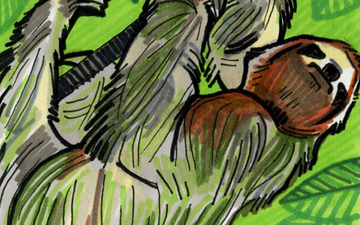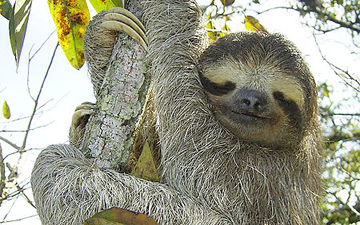The Brown-throated Sloth (Bradypus variegatus) is a species of three-toed sloth from Honduras to Colombia, Ecuador, Brazil, W Venezuela, E Perú and Bolivia, Paraguay, and N Argentina. It is a mammal classified within the Bradypodidae family. It is one of only four species of three-toed sloths; the other three being the Pygmy Sloth, the Pale-throated Sloth, and the Maned Sloth.[1]
The Brown-throated Sloth is the most widespread and common species of the group, being found in many different kinds of environments, including evergreen and dry forests and in highly perturbed natural areas.
It is a solitary, nocturnal and diurnal animal, feeding on leaves of many species of trees.
The female of the species is known to emit a loud, shrill scream during the mating season to attract males. It is a cry that sounds like “ay ay”. This scream has been remarked to sound exactly like that of a woman screaming. The male can be identified by a black stripe surrounded by orange fur on its back between the shoulders.
The Brown-throated Sloth has grayish brown to beige color fur and it is very coarse and stiff. A sloth has a round head and on it there are two eyes, a blunt nose, peg-like teeth, and ears that are not visible. The tail of a sloth is very small.
(From Wikipedia, April 25, 2010)
– – –
“Because the three-toed sloth has three extra cervical vertebrae than other mammals, including its close relative the two-toed sloth, it is able to turn its head 270 degrees, or three-quarters the way around.” (Young 1999)
(From EOL via asknature.org, April 25, 2010)
– – –





